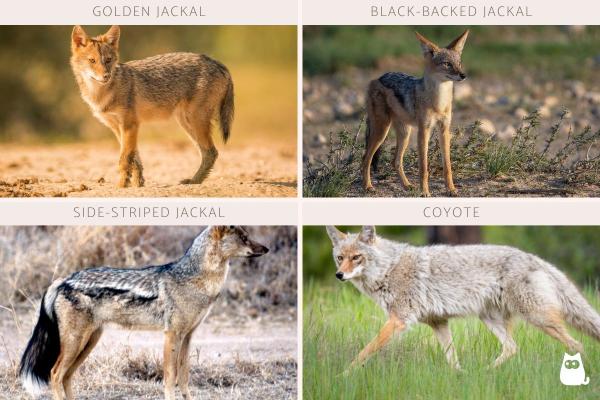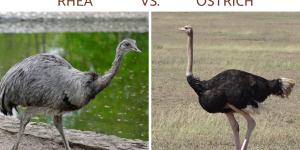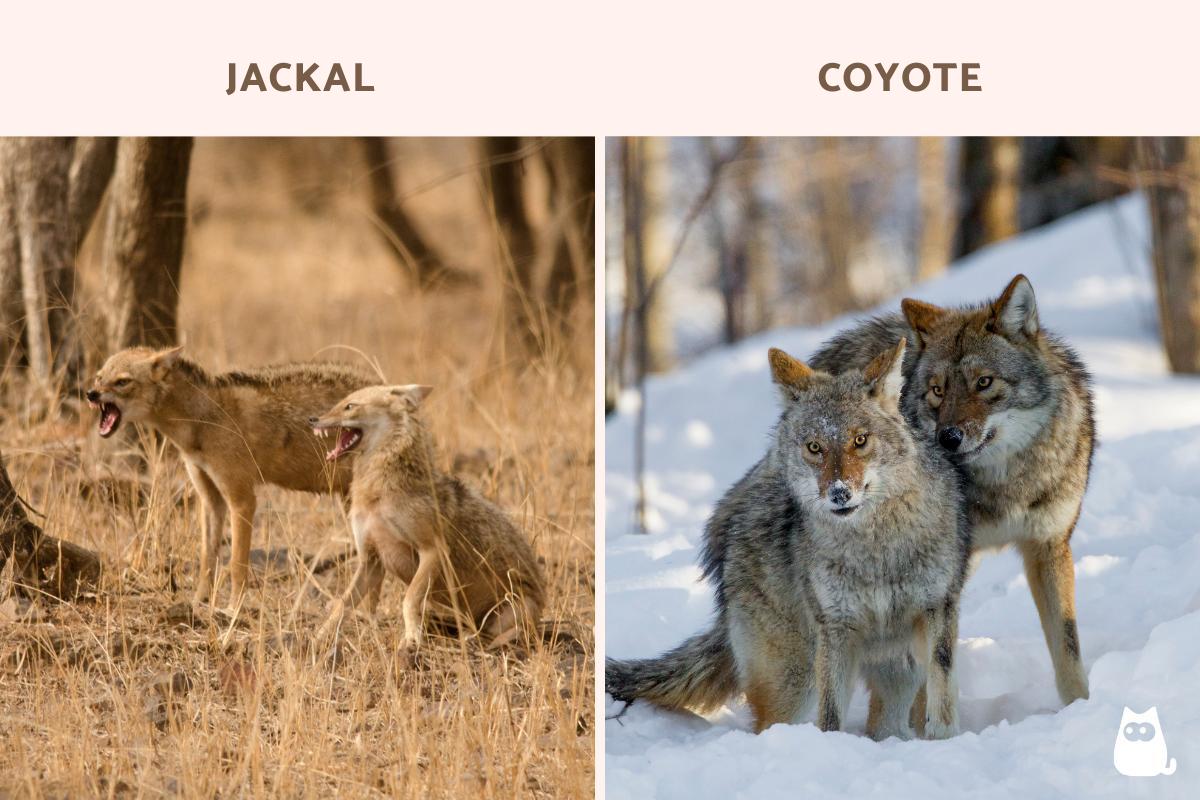Differences Between Jackal vs. Coyote


Canids are a diverse family of carnivorous mammals that have adapted to various different habitats on almost every continent. Within the family known as Canidae, there are well-known species. The one with which we have most interaction is the domestic dog, but wolves, foxes, jackals and coyotes are all other types of canids. They share certain morphological and behavioral characteristics, making some confuse one species with another. This can lead some to wonder whether a jackal and a coyote are the same animal. This is not the case and a close comparison reveals key differences to distinguish between them, despite their similarities.
At AnimalWised, we take a look at the differences between a jackal vs. coyote. To make our canid comparison, we look at their physical and behavioral differences, as well as important habitat differences which can be used to tell them apart.
Are a jackal and coyote the same animal?
No, the jackal and the coyote are not the same animal. Although both are canids, they belong to different distinct species. The jackal is not a single species, but a word used to describe three specific types of canid. They are the following:
- Black-backed jackal (Lupulella mesomelas)
- Side-striped jackal (Lupulella adustus)
- Golden jackal (Canis aureus)
Only one species of coyote can be found:
- Coyote (Canis latrans)
Despite having only one species, there are 19 recognized subspecies of coyote at time of publication. These are largely distinguished by population range, although they can have slight morphological and behavioral differences.
We learn more about the physical and behavioral differences between a jackal vs. coyote, as well as anything else important we can use as a comparison.
Physical differences between jackal vs. coyote
If viewed from a distance, it is understandable people might confuse the coyote and the jackal as the same animal. They share certain canid characteristics, such as having similar looking coats and head shape. Closer inspection reveals they have distinguishing physical differences:
Physical appearance of the jackal
All types of jackals are medium-sized mammals with physical characteristics that vary depending on species. They generally have a slender body, relatively short legs and a pointed snout. These are distinct characteristics of most canids, although some may vary slightly. Their fur, coloration and size depend on factors such as the species, season and region in which they live.
Let's look at the distinctive features of the three species of jackals:
- Golden jackal: it measures between 27.5" and 33.5" (70–85 cm) in body length, with a tail of about 9.8" (25 cm) and a height of about 15.7" (40 cm). Its fur is rough and varies from yellow to pale gold with brown tips, adapting to seasonal changes.
- Side-striped jackal: distinguished from other jackals by its more robust build, as well as shorter legs and ears. They have a white stripe running from the elbow to the hip and black lateral stripes, although these may be barely visible. Its coloration varies from light grey to tan, with a white tip on the dark tail. It is sexually dimorphic with males weighing between 16–26 lb (7.3–12 kg) and females rarely exceeding 22 lb (10 kg).
- Black-backed jackal: it gets its name from the black stripe that runs along its back from the nape of its neck to its tail. Its chest and underparts are white or rusty white, while the rest of its body is reddish brown. It is about 39" (1 m) in length and averages 15" (38 cm) at the withers. It has a sharp snout and pointed ears. During the winter, males take on a more intense reddish hue than females.
You can see the differences of these types of jackals in the pictures below.
Physical appearance of the coyote
The coyote shares several characteristics with jackals, but also has notable differences in morphology and adaptation. In terms of size, it is larger than any species of jackal, although it is still smaller than the gray wolf. It has a slender body, with a long-snouted head. Its large and pointed ears are similar to those of the black-backed jackal. One distinctive difference between the jackal and coyote is that the coyote keeps its tail drooping when running. This unlike jackals which tend to carry it more upright.
In terms of coloration, the coyote has a coat that varies from grayish brown to yellowish gray on the dorsal side. They have a whitish belly and reddish brown legs, similar to the winter coat of the black-backed jackal. Unlike the golden and side-striped jackals, the coyote doesn't change much with the seasons and maintains a more constant dark dorsal stripe made up of black-tipped hairs. Its tail is half the length of its body and similar in proportion to that of the jackals, but is distinguished by its distinct black tip and the presence of a scent gland at the dorsal base.
Another key difference between coyotes and jackals lies in their annual molt, which occurs between May and July. Coat changes in jackals are more dependent on the season and region. As far as their dentition is concerned, both coyotes and jackals are equipped with the sharp canines typical of opportunistic carnivores and molars adapted for grinding. However, coyotes have longer and thinner canines compared to jackals.
Learn about the physical differences with other canids with our article sharing the different types of wolves.

Jackal vs. coyote habitat
One reason why you may be confused between the coyote and jackal is that the coyote is sometimes colloquially known as the American jackal. This is a key to perhaps the most important difference between jackals vs. coyotes. That is the fact that coyotes are found only in the Americas, while jackals are native to Africa and parts of Asia. For this reason, you should never see a jackal and a coyote in the wild together.
Within their separate population distributions, they both show great versatility in terms of habitat preference. Both jackals and coyotes can inhabit a wide variety of ecosystems, from arid zones to forested and mountainous areas. Despite this, their distribution and behavior vary depending on the availability of resources and competition with other species.
The coyote is particularly adaptable and can be found in almost all types of habitats, including grasslands, forests, deserts, mountains and tropical regions. Its ability to exploit human resources allows it to expand into urban and suburban environments, similarly to the golden jackal. They latter also ventures into human settlements and feeds on garbage. Unlike jackals, whose distribution can be limited by competition with other species of their genus, coyotes have achieved a remarkable territorial expansion, even occupying new regions.
While golden and side-striped jackals may opportunistically frequent human areas, coyotes in suburban environments have evolved specific strategies to take advantage of urban resources. This includes consuming pet food and human food waste. Furthermore, jackal distribution is often more influenced by competition with similar species, but coyotes have managed to expand without the presence of a direct competitor. They have demonstrated a great capacity to adapt to urbanization.
You can see why many different canids can be confused with each other by taking a look at our list of animals that look like foxes.

Behavioral differences between jackal vs. coyote
Although it can't be seen in the pictures of jackals and coyotes above, the behavior of these canids is similar in terms of territoriality, vocal communication and hunting strategies. Both are usually social animals, but there are differences in their specific social structure and adaptation to human presence. We start by looking at the behavior of all types of jackals:
- Golden jackal: lives in pairs or in family units with their young which strengthens the group's protection and feeding strategies. Cooperative hunting increases their success. They mark their territory with urine to deter intruders. They are opportunistic and take advantage of the remains of prey from larger predators. They are usually nocturnal in inhabited areas and their communication includes specific howls that reinforce family bonds.
- Side-striped jackal: is strictly nocturnal, with peak activity at dusk. Usually living alone or in pairs, although in areas with abundant food it may form small groups of up to 7 individuals. It is highly vocal and its distinctive call resembles that of an owl. They are territorial and mark their areas, emitting high-pitched vocalizations in case of danger. They tend to be less carnivorous and hunt relatively rarely.
- Black-backed jackal: it is more flexible in its activity, being diurnal or nocturnal depending on its proximity to humans. It moves mainly at a trot, with keen senses that allow it to detect threats. It is territorial and aggressive when defending its space, although it avoids confrontations with larger animals. Its distrust of humans makes it difficult to observe.
Unlike jackals, the coyote rarely forms large packs and tends to hunt alone, in pairs or with close family. It is mostly nocturnal, although it can be seen being active during the day. It prefers to take advantage of pre-existing dens rather than digging them, reusing its burrows for years. It is an agile runner, capable of reaching up to 40 mph (65 km/h) and jumping up to 13' (4 m). Its adaptation to urban environments allows it to exploit human resources and move stealthily in its surroundings.
Now that you know the differences between jackals vs. coyotes, you may want to learn more about the behavior of a related canid with our article asking how often do wolves attack humans?
If you want to read similar articles to Differences Between Jackal vs. Coyote, we recommend you visit our Facts about the animal kingdom category.
- Myers, P., R. Espinosa, C. S., Parr, T., Jones, G., Hammond, S., & Dewey, T. A. (2025). The Animal Diversity Web.
https://animaldiversity.org/search/?q=Canidae&feature=INFORMATION - IUCN (2024). The IUCN Red List of Threatened Species. Version 2024-2.
https://www.iucnredlist.org







